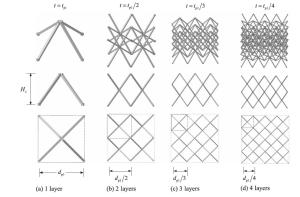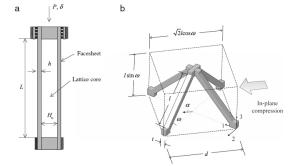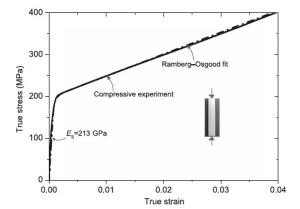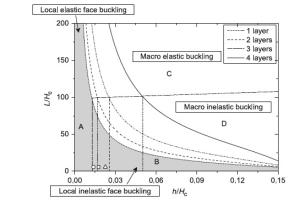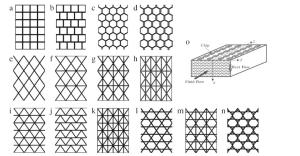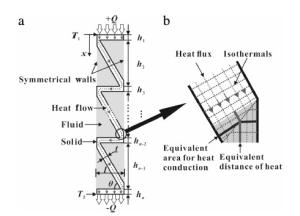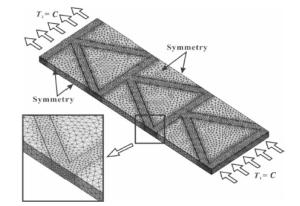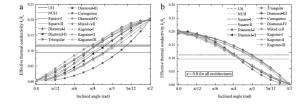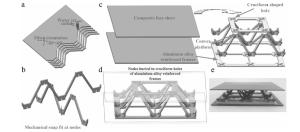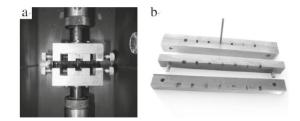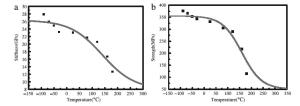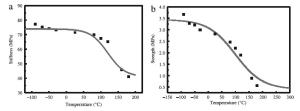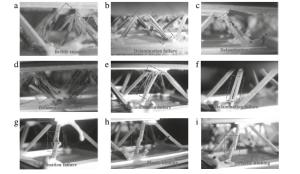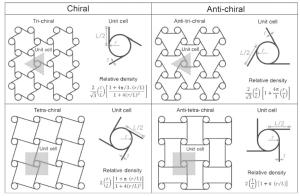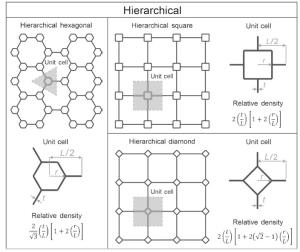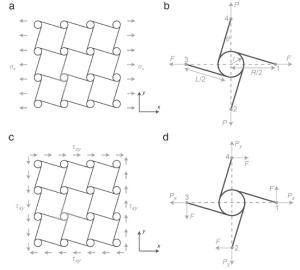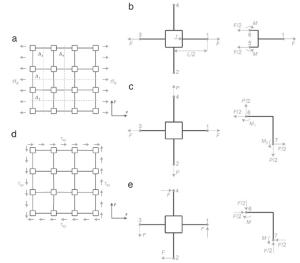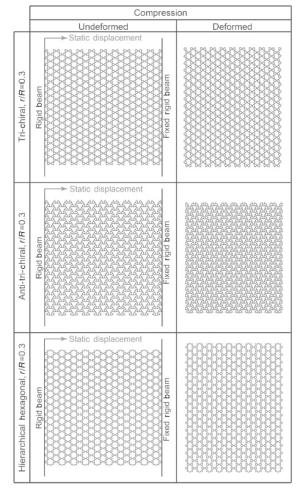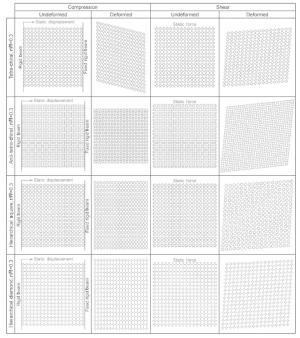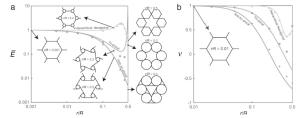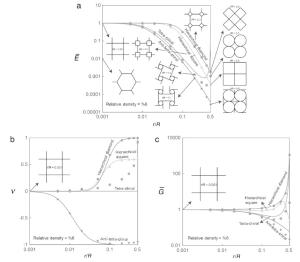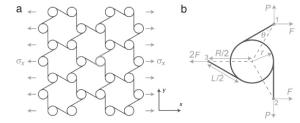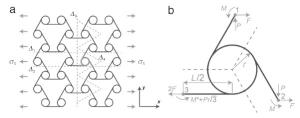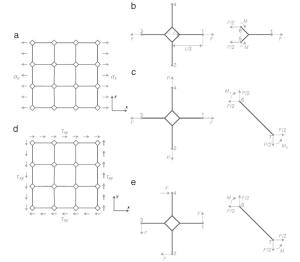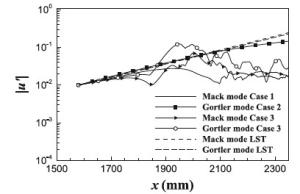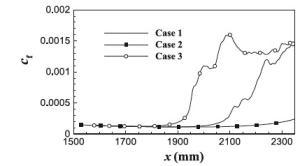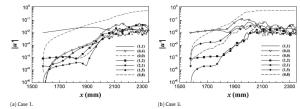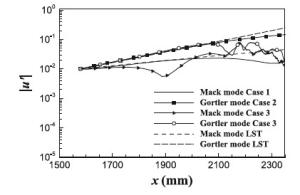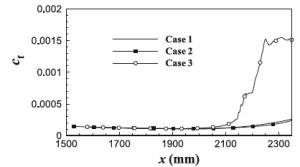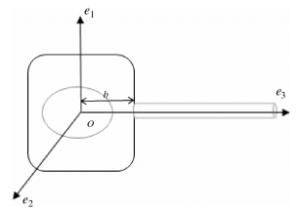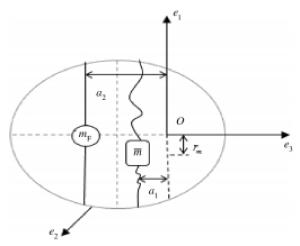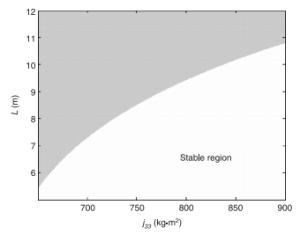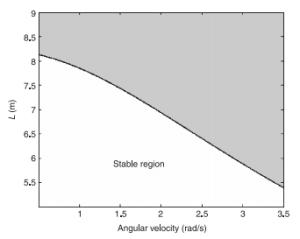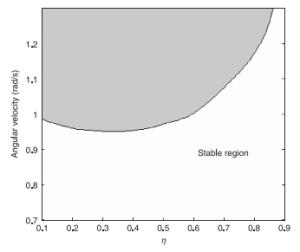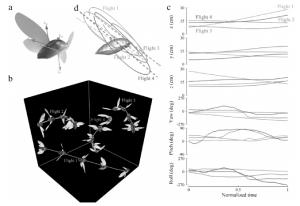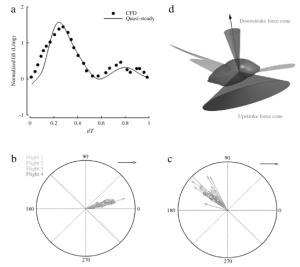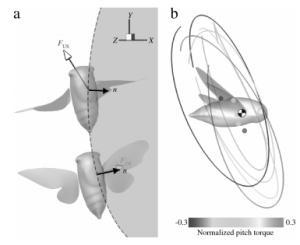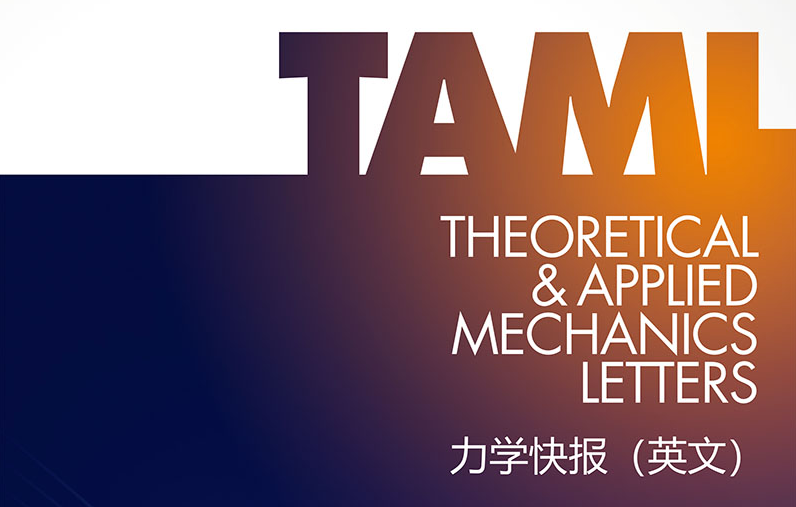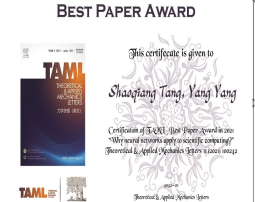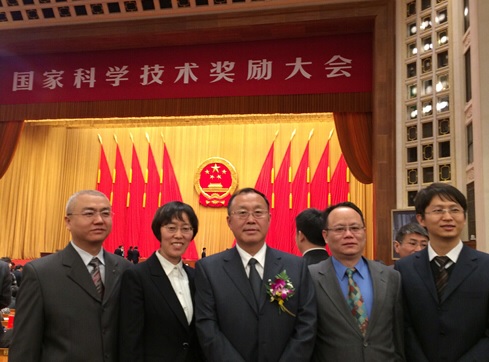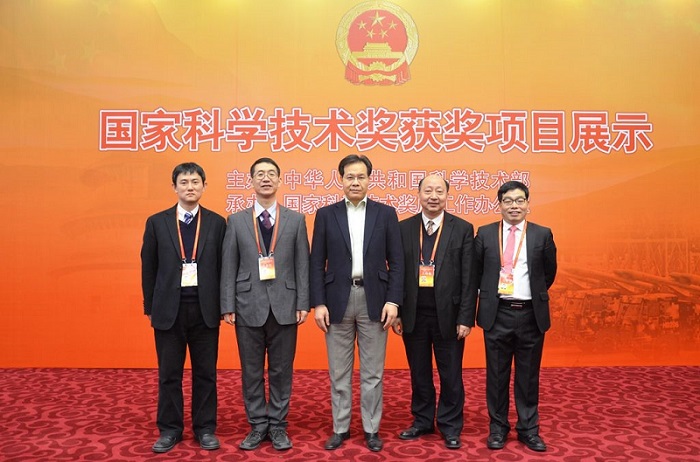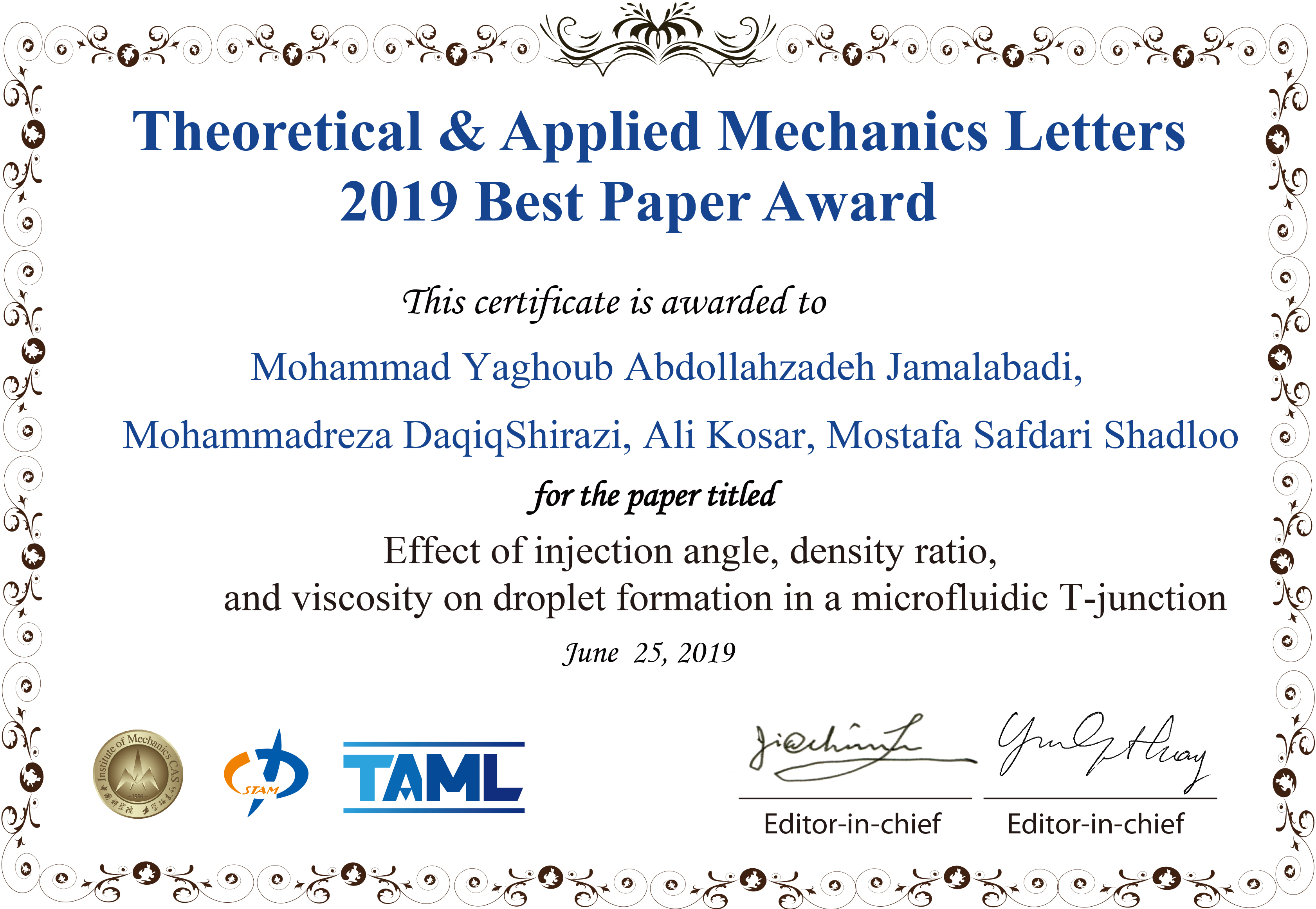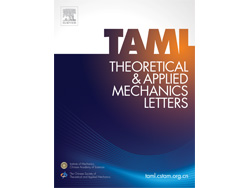Institute of Mechanics,
Chinese Academy of Sciences
2016 Vol.6(2)
Display Mode: |
Theoretical and Applied Mechanics Letters 2016, 6(2): 65-68.
doi: 10.1016/j.taml.2016.01.002
Abstract:
The effect of the face thickness to core height ratio on different multi-layer pyramidal core sandwich columns under in-plane compression is investigated theoretically and numerically. Numerical simulation is in good agreement with theory. Results indicate that one specified face thickness to core height ratio corresponds to one optimum layer number of multi-layer pyramidal core sandwich columns in consideration of engineering application. This result can guide the sandwich structure design.
The effect of the face thickness to core height ratio on different multi-layer pyramidal core sandwich columns under in-plane compression is investigated theoretically and numerically. Numerical simulation is in good agreement with theory. Results indicate that one specified face thickness to core height ratio corresponds to one optimum layer number of multi-layer pyramidal core sandwich columns in consideration of engineering application. This result can guide the sandwich structure design.
Theoretical and Applied Mechanics Letters 2016, 6(2): 69-75.
doi: 10.1016/j.taml.2016.01.003
Abstract:
A comparative optimal design of fluid-saturated prismatic cellular metal honeycombs(PCMHs) having different cell shapes is presented for thermal management applications. Based on the periodic topology of each PCMH, a unit cell(UC) for thermal transport analysis was selected to calculate its effective thermal conductivity. Without introducing any empirical coefficient, we modified and extended the analytical model of parallel series thermal electric network to a wider porosity range(0.7~0.98) by considering the effects of two-dimensional local heat conduction in solid ligaments inside each UC. Good agreement was achieved between analytical predictions and numerical simulations based on the method of finite volume. The concept of ligament heat conduction efficiency(LTCE) was proposed to physically explain the mechanisms underlying the effects of ligament configuration on effective thermal conductivity(ETC). Based upon the proposed theory, a construct strategy was developed for designing the ETC by altering the equivalent interaction angle with the direction of heat flow: relatively small average interaction angle for thermal conduction and relatively large one for thermal insulation.
A comparative optimal design of fluid-saturated prismatic cellular metal honeycombs(PCMHs) having different cell shapes is presented for thermal management applications. Based on the periodic topology of each PCMH, a unit cell(UC) for thermal transport analysis was selected to calculate its effective thermal conductivity. Without introducing any empirical coefficient, we modified and extended the analytical model of parallel series thermal electric network to a wider porosity range(0.7~0.98) by considering the effects of two-dimensional local heat conduction in solid ligaments inside each UC. Good agreement was achieved between analytical predictions and numerical simulations based on the method of finite volume. The concept of ligament heat conduction efficiency(LTCE) was proposed to physically explain the mechanisms underlying the effects of ligament configuration on effective thermal conductivity(ETC). Based upon the proposed theory, a construct strategy was developed for designing the ETC by altering the equivalent interaction angle with the direction of heat flow: relatively small average interaction angle for thermal conduction and relatively large one for thermal insulation.
Theoretical and Applied Mechanics Letters 2016, 6(2): 76-80.
doi: 10.1016/j.taml.2016.02.002
Abstract:
This paper focuses on the effect of temperature on the out-of-plane compressive properties and failure mechanism of carbon fiber/epoxy composite pyramidal truss cores sandwich panels(CF/CPTSP). CF/CPTSP with novel reinforced frames are manufactured by the water jet cutting and interlocking assembly method in this paper. The theoretical analysis is presented to predict the out-of-plane compressive stiffness and strength of CF/CPTSP at different ambient temperatures. The tests of composite sandwich panels are performed throughout the temperature range from -90℃ to 180℃. Good agreement is found between theo-retical predictions and experimental measurements. Experimental results indicate that the low temperature increases the compressive stiffness and strength of CF/CPTSP. However, the high temperature causes the degradation of the compressive stiffness and strength. Meanwhile, the effects of temperature on the failure mode of composite sandwich panels are also observed.
This paper focuses on the effect of temperature on the out-of-plane compressive properties and failure mechanism of carbon fiber/epoxy composite pyramidal truss cores sandwich panels(CF/CPTSP). CF/CPTSP with novel reinforced frames are manufactured by the water jet cutting and interlocking assembly method in this paper. The theoretical analysis is presented to predict the out-of-plane compressive stiffness and strength of CF/CPTSP at different ambient temperatures. The tests of composite sandwich panels are performed throughout the temperature range from -90℃ to 180℃. Good agreement is found between theo-retical predictions and experimental measurements. Experimental results indicate that the low temperature increases the compressive stiffness and strength of CF/CPTSP. However, the high temperature causes the degradation of the compressive stiffness and strength. Meanwhile, the effects of temperature on the failure mode of composite sandwich panels are also observed.
Theoretical and Applied Mechanics Letters 2016, 6(2): 81-96.
doi: 10.1016/j.taml.2016.02.004
Abstract:
The effects of two geometric refinement strategies widespread in natural structures, chirality and self-similar hierarchy, on the in-plane elastic response of two-dimensional honeycombs were studied systematically. Simple closed-form expressions were derived for the elastic moduli of several chiral, antichiral, and hierarchical honeycombs with hexagon and square based networks. Finite element analysis was employed to validate the analytical estimates of the elastic moduli. The results were also compared with the numerical and experimental data available in the literature. We found that introducing a hierarchical refinement increases the Young's modulus of hexagon based honeycombs while decreases their shear modulus. For square based honeycombs, hierarchy increases the shear modulus while decreasing their Young's modulus. Introducing chirality was shown to always decrease the Young's modulus and Poisson's ratio of the structure. However, chirality remains the only route to auxeticity. In particular, we found that anti-tetra-chiral structures were capable of simultaneously exhibiting anisotropy, auxeticity, and remarkably low shear modulus as the magnitude of the chirality of the unit cell increases.
The effects of two geometric refinement strategies widespread in natural structures, chirality and self-similar hierarchy, on the in-plane elastic response of two-dimensional honeycombs were studied systematically. Simple closed-form expressions were derived for the elastic moduli of several chiral, antichiral, and hierarchical honeycombs with hexagon and square based networks. Finite element analysis was employed to validate the analytical estimates of the elastic moduli. The results were also compared with the numerical and experimental data available in the literature. We found that introducing a hierarchical refinement increases the Young's modulus of hexagon based honeycombs while decreases their shear modulus. For square based honeycombs, hierarchy increases the shear modulus while decreasing their Young's modulus. Introducing chirality was shown to always decrease the Young's modulus and Poisson's ratio of the structure. However, chirality remains the only route to auxeticity. In particular, we found that anti-tetra-chiral structures were capable of simultaneously exhibiting anisotropy, auxeticity, and remarkably low shear modulus as the magnitude of the chirality of the unit cell increases.
Theoretical and Applied Mechanics Letters 2016, 6(2): 97-99.
doi: 10.1016/j.taml.2016.02.003
Abstract:
The evolution of Görtler vortices and its interaction with other instabilities are investigated in this paper. Both the Mack mode and the Görtler mode exist in hypersonic boundary-layer flows over concave surfaces, and their interactions are crucially important in boundary layer transition. We carry out a direct numerical simulation to explore the interaction between the Görtler and the oblique Mack mode. The results indicate that the interaction between the forced Görtler mode and the oblique Mack mode promotes the onset of the transition. The forced oblique Mack mode is susceptible to nonlinear interaction. Because of the development of the Görtler mode, the forced Mack mode and other harmonic modes are excited.
The evolution of Görtler vortices and its interaction with other instabilities are investigated in this paper. Both the Mack mode and the Görtler mode exist in hypersonic boundary-layer flows over concave surfaces, and their interactions are crucially important in boundary layer transition. We carry out a direct numerical simulation to explore the interaction between the Görtler and the oblique Mack mode. The results indicate that the interaction between the forced Görtler mode and the oblique Mack mode promotes the onset of the transition. The forced oblique Mack mode is susceptible to nonlinear interaction. Because of the development of the Görtler mode, the forced Mack mode and other harmonic modes are excited.
Theoretical and Applied Mechanics Letters 2016, 6(2): 100-106.
doi: 10.1016/j.taml.2016.03.001
Abstract:
sloshing dynamics was simplified as the spring mass model, and flexible attachment was modeled as the linear shearing beam. The dynamic equations and Hamiltonian of the coupled spacecraft system were given by analyzing the rigid body, liquid fuel, and flexible appendage. Nonlinear stability conditions of the coupled spacecraft system were derived by computing the variation of Casimir function which was added to the Hamiltonian. The stable region of the parameter space was given and validated by numerical computation. Related results suggest that the change of inertia matrix, the length of flexible attachment, spacecraft spinning rate, and filled ratio of liquid fuel tank have strong influence on the stability of the spacecraft system.
sloshing dynamics was simplified as the spring mass model, and flexible attachment was modeled as the linear shearing beam. The dynamic equations and Hamiltonian of the coupled spacecraft system were given by analyzing the rigid body, liquid fuel, and flexible appendage. Nonlinear stability conditions of the coupled spacecraft system were derived by computing the variation of Casimir function which was added to the Hamiltonian. The stable region of the parameter space was given and validated by numerical computation. Related results suggest that the change of inertia matrix, the length of flexible attachment, spacecraft spinning rate, and filled ratio of liquid fuel tank have strong influence on the stability of the spacecraft system.
Theoretical and Applied Mechanics Letters 2016, 6(2): 107-111.
doi: 10.1016/j.taml.2015.12.006
Abstract:
To change flight direction, flying animals modulate aerodynamic force either relative to their bodies to generate torque about the center of mass, or relative to the flight path to produce centripetal force that curves the trajectory. In employing the latter, the direction of aerodynamic force remains fixed in the body frame and rotations of the body redirect the force. While both aforementioned techniques are essential for flight, it is critical to investigate how an animal balances the two to achieve aerial locomotion. Here, we measured wing and body kinematics of cicada(Tibicen linnei) in free flight, including flight periods of both little and substantial body reorientations. It is found that cicadas employ a common force vectoring technique to execute all these flights.Weshow that the direction of the half-stroke averaged aerodynamic force relative to the body is independent of the body orientation, varying in a range of merely 20 deg. Despite directional limitation of the aerodynamic force, pitch and roll torque are generated by altering wing angle of attack and its mean position relative to the center of mass. This results in body rotations which redirect the wing force in the global frame and consequently change the flight trajectory.
To change flight direction, flying animals modulate aerodynamic force either relative to their bodies to generate torque about the center of mass, or relative to the flight path to produce centripetal force that curves the trajectory. In employing the latter, the direction of aerodynamic force remains fixed in the body frame and rotations of the body redirect the force. While both aforementioned techniques are essential for flight, it is critical to investigate how an animal balances the two to achieve aerial locomotion. Here, we measured wing and body kinematics of cicada(Tibicen linnei) in free flight, including flight periods of both little and substantial body reorientations. It is found that cicadas employ a common force vectoring technique to execute all these flights.Weshow that the direction of the half-stroke averaged aerodynamic force relative to the body is independent of the body orientation, varying in a range of merely 20 deg. Despite directional limitation of the aerodynamic force, pitch and roll torque are generated by altering wing angle of attack and its mean position relative to the center of mass. This results in body rotations which redirect the wing force in the global frame and consequently change the flight trajectory.
 Submit a Paper
Submit a Paper
 Subscription
Subscription
News
MORE+
Call for Papers
MORE+
- Crossing-Mechanics Driven by Big Data
- Machine learning in the fluid mechanics research of wind energy
- Mechanics of Origami/Kirigami structures and metamaterials
- New insights and perspectives on impact biomechanics for human tissues: from injury prevention, protection to protective equipment
- Environmental Mechanics for Extreme Natural Events



